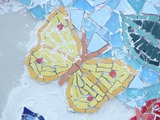
Butterfly adaptations are linked to Greek and Roman mosaics.
- Subject:
- Cross-Curricular
- Measurement and Geometry
- STEM/STEAM
- Visual Art
- Material Type:
- Lesson
- Author:
- Jamie Marquitz
- Amy Erb
- Candice Anthony-Cazenave
- Jessica Brown
- Date Added:
- 12/23/2020

Butterfly adaptations are linked to Greek and Roman mosaics.

This lesson plan contains research links and a "How to Video" to help guide students through researching plants and animals native to Virginia.

This is a short description intended to catch the reader and make them want to open your lesson.Bring a rural-cultural atmosphere to your classroom by hatching chicken eggs. Students will be able to compare basic to high tech incubators and compare how technology has influenced and advanced in order to meet cultural needs.

Video Description: In this close-up video, Dr. Lola Fatoyinbo Agueh, a Research Physical Scientist at NASA's Goddard Space Flight Center, shares her love for exploring new places and passion for studying Earth, from the ground to satellite imagery. Video Length: 1:51NASA eClipsTM is a suite of online student-centered, standards-based resources that support instruction by increasing STEM literacy in formal and nonformal settings. These free digital and downloadable resources inform and engage students through NASA-inspired, real-world connections.NASA eClips Ask SME: Close-up with a NASA Subject Matter Expert videos are professionally developed to capture a glimpse of NASA SME's personal interests and career journeys. Each can be used to spark student interest and broaden their ideas of the STEM workforce. Additional videos in this series can be found by searching GoOpenVA using "NASA eClips Ask SME".

Video description: In this close-up video, Jacob Torres, Technical and Horticultural Scientist at NASA's Kennedy Space Center, shares how space biology brings together his love of engineering and growing plants. For his work, he builds technology that supports growing crops in ways that have never been done before. Video length: 2:35.NASA eClipsTM is a suite of online student-centered, standards-based resources that support instruction by increasing STEM literacy in formal and nonformal settings. These free digital and downloadable resources inform and engage students through NASA-inspired, real-world connections.NASA eClips Ask SME: Close-up with a NASA Subject Matter Expert videos are professionally developed to capture a glimpse of NASA SME's personal interests and career journeys. Each can be used to spark student interest and broaden their ideas of the STEM workforce. Additional videos in this series can be found by searching GoOpenVA using "NASA eClips Ask SME".

Video Description: No matter where plants grow, they have the same basic needs: water, nutrients, light, temperature, and atmosphere. No matter where humans may live, they need plants. Dr. Gioia Massa explains how NASA grows plants on the International Space Station in preparation for growing plants beyond Earth and, someday, on the Moon and Mars. Jacob Torres describes the hardware needed to provide open and closed systems for plant growth in space. This video shows how NASA scientists and engineers work together to learn more about ways plants live, grow, and adapt to live in varying environments. Video Length: 5:44.NASA eClips Our World videos (grades 3-5) help students understand the differences between science (the natural world) and engineering (the designed world). These video segments supplement elementary learning objectives not only in science, technology, engineering and mathematics, but also in reading, writing, visual and performing arts.

NASA eClips Our World: Where Do We Find Extremophiles?Video Description: Where do we find extremophiles? We look for environments that push the limits for ordinary living organisms. NASA conducts analog testing in these extreme environments to better understand life on Earth and identify the potential for life in the universe. Video Length: 3:25. NASA eClipsTM is a suite of online student-centered, standards-based resources that support instruction by increasing STEM literacy in formal and nonformal settings. These free digital and downloadable resources inform and engage students through NASA-inspired, real-world connections.NASA eClips Our World videos (grades 3-5) help students understand the differences between science (the natural world) and engineering (the designed world). These video segments supplement elementary learning objectives not only in science, technology, engineering and mathematics, but also in reading, writing, visual and performing arts.

This lesson allows students to experience coding in a low stress, engaging environment while reinforcing thier learning about food webs and the interrelationships of the animals. No prior coding experience is required for the teacher or the students. Teachers and students will be walked through the steps of creating a cartoon demonstrating the transfer of energy in the food web. They will learn to use sequencing, loops, variables, and opperations on those variables all while creating a fun moving cartoon. Once students have learned the basic moves, they will be able to code further steps independently to add more interest to their cartoon.

This lesson connects the invention of the x-ray by Tesla to the artwork of Austrailian Aboriginals.